OILFIELDS, STALINGRAD IN NAZIS’ 1942 CROSSHAIRS
Along the Eastern Front · June 28, 1942
On this date in 1942 on the Eastern Front, Adolf Hitler launched Germany’s second summer campaign against the Soviet Union in two years. (The first had been Operation Barbarossa begun the previous June, which had been intended to knock the Soviet Union out of the war.) Ignoring the Soviet capital Moscow, whose fierce defense combined with a brutal winter had prevented its capture earlier in the year, Fall Blau (Operation Blue in English) was instead directed south toward the strategic Caucasus oil and mineral fields and important centers of Soviet war industry.
The German armored advance resembled a knife slicing through a stick of butter—a rerun it seemed of the summer of 1941, when the Red Army fell apart on the first armored impact. Making steady progress across the empty Ukrainian steppes, Army Group South (A) took the key railway junction and river port Rostov-on-Don on July 23, and then drove south to the oilfields in the Caucasus. On August 23 Gen. Friedrich Paulus’ Sixth Army, part of Army Group South (B), entered the outskirts of Stalingrad (today’s Volgograd), a vital manufacturing and transport center upstream from Rostov. That same day a massive German air raid on Stalingrad caused a firestorm that killed thousands of civilians and turned the city of 900,000 residents into a landscape of rubble and burned ruins.
Neither Germany nor the Soviet Union could have foreseen the horror that would face each other at Stalingrad. Paulus’ Sixth Army was inexorably drawn into a Soviet quagmire from which it was nearly impossible to escape. The 199-day battle for control of Stalingrad produced a monumental two million casualties on both sides. Stalingrad was the worst defeat the Soviets inflicted on Axis forces up to that time. Some 105,000 enemy prisoners were led away, most to their deaths. Only 6,000 POWs lived through their ordeal to return to their homeland after the war.
Stalingrad proved to be a major turning point in the European war, and for the first time the Western Allies began to hope the Soviets might triumph in their titanic confrontation with the Nazi invaders. Smelling blood, President Franklin D. Roosevelt announced at the conclusion of the Casablanca Conference in Morocco between himself, British Prime Minister Winston Churchill, and their joint chiefs of staff (January 14–23, 1943) that the Allies would require nothing less than Germany’s “unconditional surrender.”
[amazon_carousel widget_type=”ASINList” width=”600″ height=”200″ title=”Recommended Reading” market_place=”US” shuffle_products=”False” show_border=”False” asin=”141657350X,0312868537,0700619542,1844159345,0140284583,190916058X,0700619011,0813134161,0764343432,B00GMP6IBM” /]
Stalingrad 1942: Turning Point in the Soviets’ “Great Patriotic War”
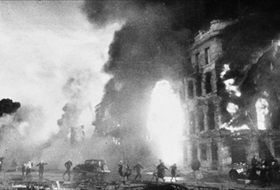 | 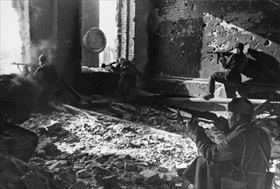 |
Left: Beginning on August 23, 1942, the Luftwaffe bombed Stalingrad block-by-block for five straight days. Firestorms killed anywhere from 25,000 to 40,000 people. After August 25, the Soviets stopped recording civilian and military casualties as a result of air raids. The Luftwaffe also rendered the River Volga, vital for ferrying supplies into the besieged city, unusable to Soviet shipping. Photo from late August 1942.
![]()
Right: Stalingrad’s desperate defenders realized that their best defense consisted of anchoring their defense lines in numerous buildings. Thus they converted multistory apartment houses, factories, warehouses, corner residences, and high-rise office buildings into strongholds bristling with machine guns, antitank rifles, mortars, mines, barbed wire, snipers, and small 5–10 man units of submachine gunners and grenadiers prepared for house-to-house, hand-to-hand combat.
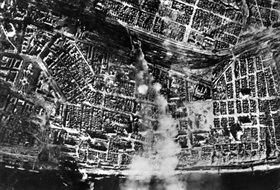 | 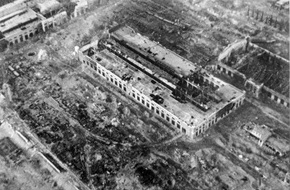 |
Left: A reconnaissance photo of a railway station burning in Stalingrad, late August 1942. One railway station changed hands 14 times in six hours. The Germans killed 2,500 Soviet soldiers each day, day after day, three times their losses.
![]()
Right: German bombers flatten Stalingrad’s industrial center, November 16, 1942. The Luftwaffe retained air superiority into early November, but after flying 20,000 individual sorties, its original strength of 1,600 serviceable aircraft had shrunk to 950. It shrank further following Allied landings in North Africa (Operation Torch) in November 1942, when Germans were forced to withdraw aircraft from the Eastern Front in an ultimately failed attempt to save Axis fortunes in the Mediterranean.
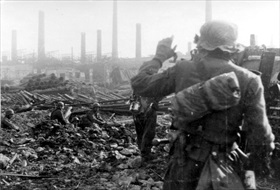 | 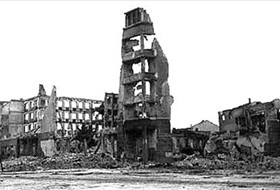 |
Left: German infantry try to find cover in the wilderness of rubble that Stalingrad had become. Photo from September 23, 1942. Bitter fighting raged for every factory, rubble-strewn street, house, basement, stairwell, and sewer. The Germans called this ever-present, often unseen urban warfare Rattenkrieg (“Rat War”). They bitterly joked about capturing the kitchen but still having to fight for the living room and the bedroom.
![]()
Right: A scene of the destroyed city center, Stalingrad, date unknown but likely autumn 1942. The Battle of Stalingrad bled the German Army dry and turned the war in the East decisively against Nazi Germany. For the heroism of its defenders, Stalingrad was one of four cities awarded the title “Hero City” in 1945.
Battle of Stalingrad, August 23, 1942, to February 2, 1943
![]()

 History buffs, there is good news! The Daily Chronicles of World War II is now available as an ebook for $4.99 on Amazon.com. Containing a year’s worth of dated entries from this website, the ebook brings the story of this tumultuous era to life in a compelling, authoritative, and succinct manner. Featuring inventive navigation aids, the ebook enables readers to instantly move forward or backward by month and date to different dated entries. Simple and elegant! Click
History buffs, there is good news! The Daily Chronicles of World War II is now available as an ebook for $4.99 on Amazon.com. Containing a year’s worth of dated entries from this website, the ebook brings the story of this tumultuous era to life in a compelling, authoritative, and succinct manner. Featuring inventive navigation aids, the ebook enables readers to instantly move forward or backward by month and date to different dated entries. Simple and elegant! Click 











